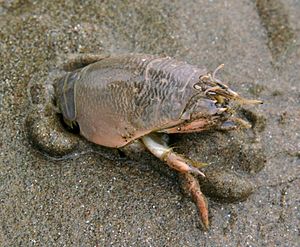Hippoidea
| Hippoidea | ||||||||||||
|---|---|---|---|---|---|---|---|---|---|---|---|---|

|
||||||||||||
| Systematics | ||||||||||||
|
||||||||||||
| Scientific name | ||||||||||||
| Hippoidea | ||||||||||||
| Latreille , 1825 |
The Hippoidea are a world-wide spreading superfamily of the middle crabs . They include mole crabs and sand crabs, for which a burrowing way of life in the marine littoral is typical.
features
The carapace of the hippoidea is ovoid to approximately rectangular. It is covered with clear, mostly transverse depressions, which in Blepharipodidae and Albuneidae can be provided with bristles. The antennae (the first pair of antennae ) can be extended in deep burrowing taxa to form a breathing tunnel. The eyes of the hippoidea are variable. The shape of the stalks on which the cornea rests ranges from long, stalk-shaped to comparatively short and plate-shaped. The mouthparts are either adapted to scavenging or to filtering plankton or detritus . The gills are on one axis (trichobranchiate) or are leaf-shaped in pairs (phyllobranchiate). The first stride leg can have so-called subchela or in the Hippidae it can be completely without scissors. The pairs of striding legs two to four have a flat dactylus that can be used to dig in sandy substrates. Swimming legs are absent in males or are reduced in some Albuneidae. The telson is always folded under the abdomen , the uropods do not form a tail fan .
Hippoidea have lost the ability to walk and use their striding legs to dig themselves backwards in the sand relatively quickly. Some hippoidea can also swim backwards by paddling with their striding legs or with the uropods during what is known as "tail flipping". Other species of decapod crabs also dig, but the backward digging of the hippoidea seems to differ from that and thus to be a typical feature.
Systematics
All phylogenetic studies indicate that the hippoidea are the basal taxon of the crustaceans. The three families of the Hippoidea are themselves monophyletic, the Blepharipodidae described in 2002 are probably the sister taxon to the mole crabs and sand crabs. The families differ in the shape of the gills (trichobranchiate or phyllobranchiate) and the absence or presence of a subchela on the first stride leg.
The hippoidea consist of the following three families:
- Mole crabs (Albuneidae Stimpson, 1858 )
- Blepharipodidae Boyko, 2002
- Sand crab (Hippidae latreille, 1825 )
Individual evidence
- ↑ a b c C.B. Boyko, PA McLaughlin: Annotated checklist of anomuran decapod crustaceans of the world (exclusive of the Kiwaoidea and families Chirostylidae and Galatheidae of the Galatheoidea) Part IV - Hippoidea . In: The Raffles Bulletin of Zoology . Supplement No. 23, 2010, p. 139–151 ( PDF, 296kB [accessed February 9, 2013]).
- ↑ a b C.B. Boyko: A worldwide revision of the recent and fossil sand crabs of the Albuneidae Stimpson and Blepharipodidae, new family (Crustacea: Decapoda: Anomura: Hippoidea) . In: Bulletin of the American Museum of Natural History . tape 272 , 2002, pp. 1–396 ( PDF, 47MB [accessed February 9, 2013]).
- ^ Z. Faulkes, D. Paul: Digging in sand crabs (Decapoda, Anomura, Hippoidea): interleg coordination . In: The Journal of Experimental Biology . tape 200 , 1997, pp. 793-805 ( link to full text [accessed February 9, 2013]).